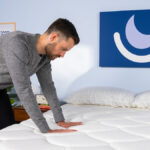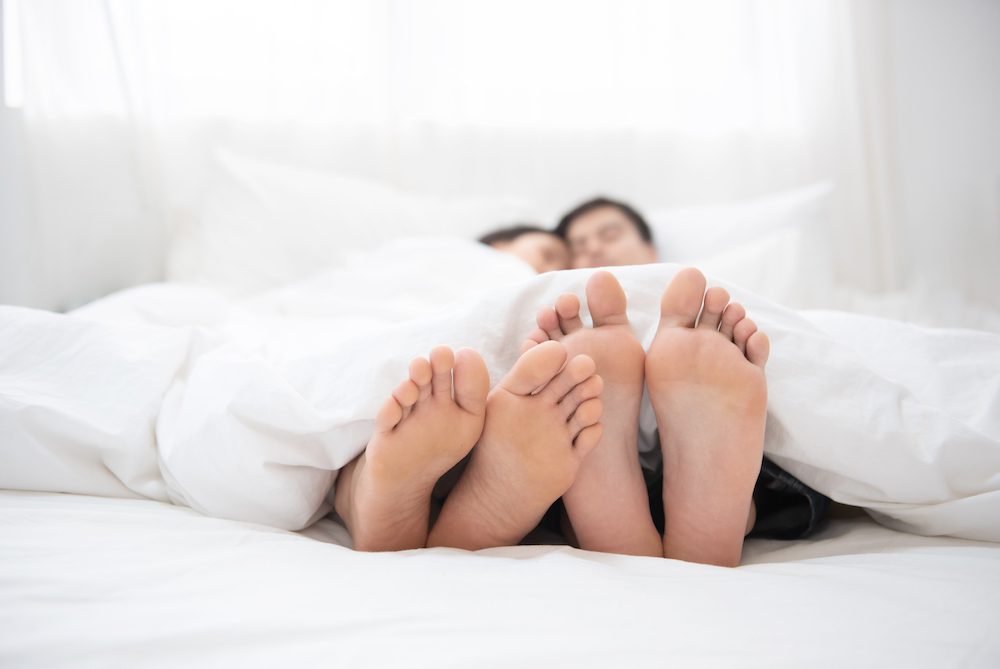Nocturnal seizures happen during sleep or just after waking up. Sometimes a seizure is an isolated event and only happens once. In other cases, seizures are due to epilepsy, a condition characterized by recurrent seizures that might happen at night or during the day.
Some types of nocturnal seizures may be hard to distinguish from other sleep problems. Learning about the signs of nocturnal seizures and what to do when you think one has occurred can help ensure the right treatment and minimize the risk of complications or injury.
What Happens During a Nocturnal Seizure?
Nocturnal seizures, like seizures that occur while a person is awake, are due to abnormal electrical activity in the brain. Seizures disrupt communication among neurons, which are cells that provide instructions to the body on how to function. What happens during a nocturnal seizure can depend on the type of seizure and which parts of the brain are affected.
Nocturnal seizures are usually brief, lasting several seconds to about two minutes. A person may or may not be aware that they have had a seizure during their sleep. Some types of seizures happen right after waking up.
A nocturnal seizure can be a one-time event or a person may have recurrent seizures due to a condition called epilepsy. There are many types of epilepsy. Epileptic seizures that primarily occur during sleep or after waking are called nocturnal epilepsy or sleep-related epilepsy.
Generalized seizures affect both sides of the brain and can be classified as a tonic-clonic or an absence seizure. Tonic-clonic seizures can cause convulsions, vocalizations, and loss of consciousness if they occur while awake. Absence seizures can cause unusual feelings like an altered state of awareness or twitching of the eyelids or specific muscle groups.
Focal seizures begin in one part of the brain, but sometimes affect other areas as well. Focal seizures are classified based on a person’s level of awareness during or after the seizure event and whether any abnormal movements occur. Focal seizures can cause a range of abnormal movements in different parts of the body, like repetitive motions, stiffness, or spasms.
How Do Seizures Affect Sleep?
The relationship between sleep and seizures is complex. Nocturnal seizures can disrupt the sleep cycle and affect a person’s sleep quality leading to daytime sleepiness and fatigue during the day.
It is normal for electrical activity to fluctuate while moving through the different stages of sleep. Changes in electrical activity during sleep have been shown to promote or suppress seizure activity, especially in people who have epilepsy.
During sleep, the brain usually slows down and rests. But in the case of people who have seizures, their brains can become too active, which can cause a seizure. This often happens during a certain stage of sleep called non-rapid eye movement (NREM) sleep,
Researchers have observed that seizures may interfere with other important functions of sleep, like memory formation. This is because seizures are more likely to occur during the deeper stages of NREM sleep when the brain activates processes involved in retaining information and making new memories.
Signs You Had a Seizure in Your Sleep
The signs and symptoms of a seizure, particularly those that occur during sleep, can vary widely and may be hard to recognize. When a person has a nocturnal seizure, they may not be aware of what has occurred, even if the seizure causes them to wake up. Upon waking, a person who has had a seizure may be disoriented and have no memory of the event.
Signs that a seizure has occurred during sleep may include:
- Daytime sleepiness
- Soiled bedding from urine, feces, or vomit
- Bitter or metallic taste in the mouth
- Physical injury
Someone observing a person having a seizure in their sleep may confuse the signs of a seizure with other sleep problems like night terrors, sleep-related movement disorders, or sleepwalking. However, some seizure activity is more obvious, like convulsions or rapid and repetitive movements of one or more parts of the body. Other signs include:
- Clenching of the jaw
- Drooling
- Vocalizations like grunting or groaning
- Pauses in breathing
- Twitching muscles
A seizure may be a medical emergency, especially if the person does not have a history of seizures. If you witness a person having an unexpected seizure, a seizure that lasts longer than five minutes, or one that results in serious physical injury or a continued loss of consciousness, contact emergency medical services immediately.
What Causes a Seizure in Your Sleep?
There are a variety of factors that might trigger a seizure, though in many cases the exact cause cannot be determined. Sometimes seizures are triggered by a health problem, including:
- Stress
- Sleep deprivation
- High fever
- Brain infection
- Stroke
- Traumatic brain injury
- Withdrawal from drugs or alcohol
If two or more seizures occur more than 24 hours apart, a person may be diagnosed with epilepsy. Some people are born with epilepsy because of a birth injury or an inherited genetic condition. When epilepsy develops in childhood, adolescence, or adulthood, it is usually difficult to identify the cause.
How Nocturnal Seizures Are Diagnosed
Nocturnal seizures can be difficult to diagnose. Some of the typical signs of nocturnal seizures— like twitching, vocalizing, or waking in a confused state—are often mistaken for other sleep disorders or health problems. If a person experiencing seizures typically sleeps alone, there may not be an opportunity for their symptoms to be noticed by another individual.
Diagnosing the cause of nocturnal seizures may require a series of exams and tests. In many cases, the diagnostic process begins in an emergency room and may involve a referral to a neurologist, a doctor who specializes in brain disorders.
- Initial Evaluation: A doctor will want to know details about what occurred before, during and after a possible nocturnal seizure. If another person witnessed the seizure, it is helpful for them to be present during the appointment. Some seizure disorders run in families, so it may be relevant to provide a family health history when possible.
- Blood Tests: Blood tests are ordered to assess a person’s overall health status and to check for signs of health problems that may have triggered a seizure like low blood sugar or an infection.
- Electroencephalogram (EEG): An EEG is a test that monitors and records electrical activity in the brain through electrodes on the scalp. EEG monitoring can take place at home over a 24-hour period or in the hospital over several days.
- Polysomnography (PSG): Some doctors might recommend a PSG, or sleep study, with video monitoring, in order to observe the brain’s electrical activity during the different stages of sleep. A sleep study can also be useful in differentiating epilepsy from other sleep disorders, especially parasomnias.
- Brain Imaging Tests: An MRI can be used to look for abnormalities in the brain like a tumor or an injury that may trigger a seizure. MRIs use powerful magnets and computers to capture images of the brain.
Treatment Options for Nocturnal Seizures
Treatment for nocturnal seizures depends on whether the seizure was caused by an epilepsy disorder or by another underlying health problem. Treatment is usually effective at slowing the frequency of seizures or stopping them altogether.
There are two main options for treating epilepsy-induced seizures.
- Medications: Anti-seizure medications are the most common treatment for people with epilepsy. There are many types of anti-seizure medications, and if the first one doesn’t work, other medications may be an option.
- Surgery: Surgery is a more invasive treatment option for epilepsy, but it may be recommended if anti-seizure medications do not work. Surgery involves removing the part of the brain where seizures originate from or installing a device that blocks certain brain signals. Surgery may be an option for treating certain types of focal epilepsies.
Other types of support may also be helpful for people with nocturnal seizures.
- Diet: For some people with epilepsy, particularly children, adapting to a low- carbohydrate, high-fat diet can help control seizures. It’s important to consult with a health care provider before making significant dietary changes.
- Education: Living with epilepsy may require making changes to a person’s daily routine or environment in order to avoid triggers and prevent injury during a seizure. A person’s health care team can help them understand their condition and what they can do to reduce the risk of complications or injury.
- Counseling and Support Groups: Epilepsy may have an impact on a person’s quality of life and increases the risk of depression and anxiety. Finding support can help a person cope with any mental health problems or lifestyle changes that occur after an epilepsy diagnosis.
People who only have one seizure may not need treatment, but should still be evaluated by a doctor. Certain types of epilepsy, particularly those that begin in childhood, may spontaneously resolve as a person reaches adulthood. Other types of epilepsy are chronic conditions and may need continued treatment and monitoring throughout a person’s lifetime.
Reducing the Effect of Nocturnal Seizures
People who have nocturnal seizures are at risk of unknowingly injuring themselves or their bed partner. Undergoing treatment and avoiding triggers may help prevent or reduce the frequency of future seizures. However, seizures may still happen, and there are several steps that may help to reduce the impact of nocturnal seizures.
- Improve Bedroom Safety: Consider what kind of objects or furniture are around your bed. Remove anything sharp or made of glass from your nightstand. Moving your mattress to the floor or lowering the height of your bed may also help limit the risk of falling during a nocturnal seizure.
- Sleep With Supervision: If possible, have a partner or caregiver monitor you while you sleep. Experts believe that lack of monitoring may contribute to serious health outcomes, suffocation, and delayed medical assistance during nocturnal seizures.
- Change Your Sleep Position: Try to sleep on your side. Avoid sleeping on your back or stomach. Lying on your stomach is linked to increased risk of serious complications, including death in people with epilepsy. If you throw up during a seizure, sleeping on your back may result in choking.
- Wear Loose Sleepwear: Go to sleep wearing loose clothing. Do not wear sleepwear or jewelry that can tighten around your neck or restrict your breathing.
- Unlock Your Doors: Keep your bedroom door unlocked and remove obstacles and clutter from blocking your door. Making your room accessible for others may make it easier for people to enter your bedroom to help you during a medical emergency.
- Wear a Medical ID Bracelet: If you have a seizure disorder, sleep with a bracelet that lists your medical information and has an emergency contact number. Reach out to your family, friends, and roommates and suggest they complete a seizure first aid course so they can better support you.
- Tell Your Roommates: Consider telling your roommates about your nocturnal seizures, including how they should respond when seizures occur and when to request medical assistance for you.
When to Contact a Doctor
Sometimes a seizure is a medical emergency, especially if the person does not have a history of epilepsy. Anyone observing the seizure should call 911 or other emergency services immediately. Signs that a seizure is a medical emergency include:
- This is the person’s first seizure
- The person has diabetes
- The person is pregnant
- The seizure lasts longer than five minutes
- A second seizure occurs quickly after the first one
- The person does not regain consciousness
- The person is injured during a seizure
If you witness a person having a nocturnal seizure, you can take several steps to help prevent injury.
- Roll the person to their side
- Do not put anything in their mouth
- Loosen any clothing or jewelry that might be restricting their neck
- Do not try to shake them or wake them up
- Remove any bedding or nearby objects that might restrict movement or cause harm
- Stay with them during and after the seizure
Experiencing a seizure or witnessing another person having a seizure can be upsetting. However, taking the appropriate steps to secure the environment and contacting emergency services when necessary can reduce the risk of serious complications.
If you suspect that you or someone you care for is having nocturnal seizures, contact your primary health care provider. Be prepared to share detailed information about what signs you have noticed, whether you’re experiencing sleep problems, and any other health changes that have occurred.
References
Ask the Sleep Doctor
Have questions about sleep? Submit them here! We use your questions to help us decide topics for articles, videos, and newsletters. We try to answer as many questions as possible. You can also send us an email. Please note, we cannot provide specific medical advice, and always recommend you contact your doctor for any medical matters.



